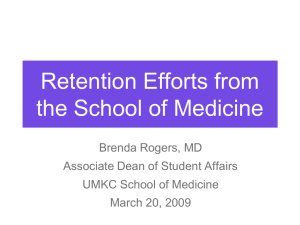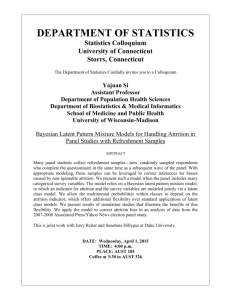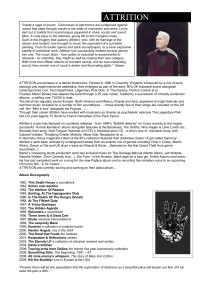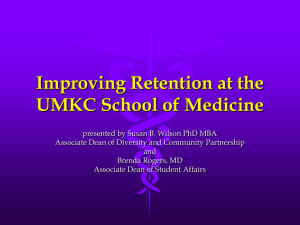Attrition in the LS: issues, results, and conclusions Lucinda Platt University of Essex
advertisement
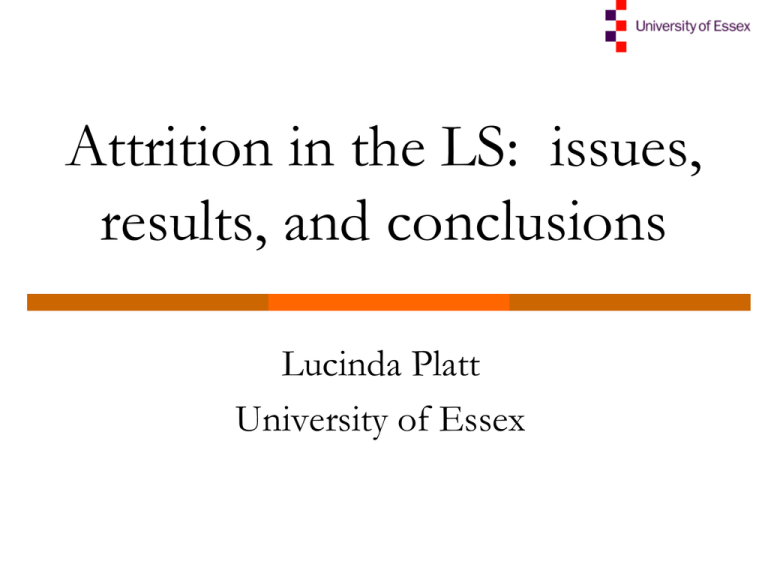
Attrition in the LS: issues, results, and conclusions Lucinda Platt University of Essex The Longitudinal Study The LS is a record-linkage study of one per cent of the population of England and Wales. It was initially obtained by taking a sample of the 1971 Census, based on those born on one of four birth dates (day and month). At each subsequent Census, information from samples taken using the same sampling criteria is linked where possible. Between censuses, members are added to the study by linking information on births and immigrations, again using the same sampling criteria. Information on death and emigration from England and Wales is also linked to the study. Nor further information is lined for sample members who have died or emigrate, although linkage recommences for members who return to England and Wales. Acknowledgements The permission of the Office for National Statistics to use the Longitudinal Study is gratefully acknowledged, as is the help provided by the Centre for Longitudinal Study Information & User Support (CeLSIUS), in particular Julian Buxton. The above, however, bear no responsibility for the interpretation of the data. Census output is Crown copyright and is reproduced with the permission of the Controller of HMSO and the Queen’s Printer for Scotland. Using the LS to study social mobility and ethnicity (1) Aim of the study To look at transitions between parents’ social class and children’s social class, examining the contribution of additional independent or intervening factors To look at how these transitions vary by ethnic group To draw inferences about relative equality of opportunity according to class and ethnic group Using the LS to study social mobility and ethnicity (2) Advantages: Can look over extended periods Can look at differences by ethnic group Can measure mobility prospectively rather than retrospectively. This latter point raises its own issues: We know that not all those who we start out with are there at the end (called ‘attrition’ for the purposes of this paper, though not the same as how we typically characterise attrition in longitudinal resources)? (If mobility is measured using a retrospective approach then the point of measurement is only those who are still left) Studying mobility with the LS Not observed 2nd generation – but we know something about them ‘Representative’ 2nd generation: observed destinations Both origin and destination observed not recalled Parents of ‘hard to reach’ (not sampled): observed origins Parents of Emigrants: observed origins Parents of sample: observed origins No outcomes (destinations) Non-parents (not observed) Selection in retrospective studies Not observed 2nd generation ‘Representative’ 2nd generation: observed destinations Provides information about Parents of ‘hard to reach’ (not sampled): Not observed origins Parents of Emigrants: Not observed origins Parents of sample: observed origins No outcomes (destinations) Non-parents (not observed) Study design Two cohorts (one from 1971 and one from 1981) of ONS Longitudinal Study members aged 4-15 living with at least one parent. Information about ‘origins’ captured at these points (1971 / 1981). Information about the cohorts’ ‘destinations’ is measured in 2001 for both cohorts and additionally in 1991 for the 1971 cohort. Pooling of the cohorts increases sample sizes and also enables some exploration of whether there appear to be cohort effects. Pooled outcomes are measured both at 2001 and ‘after two decades’ to compare measurement at the same point in time with measurement across the same age range. Variables used For ‘origins’ whether one or two co-resident parents, parents’ social class, housing tenure, car ownership, parents’ countries of birth, study member’s country of birth, parents’ educational qualifications, concentration of minority group members in ward of residence For ‘destinations’ ethnic group, study member’s and spouse’s social class and economic status, partnership status, educational qualifications, housing tenure, car ownership, whether died, whether emigrated Variables were harmonised to be equivalent across both cohorts Measurement of ethnicity Based on 1991 ethnicity but supplemented by 2001 information where 1991 ethnic group not available, on the principles of 1991 ethnic group categorisation. Black other and Black Caribbean combined to form a Caribbean group. The white group was restricted to those where both parents were born in the UK; additionally a white migrant group was created to identify any migration effects distinct from ‘ethnicity’ effects. For those who were not present in 1991/2001, a proxy ethnicity based on parents’ country of birth was created, and validated by comparison with parents’ birthplace for those who were present at 1991/2001 (and, for 1971, with the ethorx variable). Extent of loss to follow up Total size of cohort Number retained after 2 decades Number retained after 2 decades as % of total 83.3 78.4 80.9 1971 Cohort 90702 75571 1981 Cohort 86925 68183 Pooled 177627 143754 Sample Source: ONS Longitudinal Study, author’s analysis Number retained at 2001 Number retained at 2001 as percent of total 73120 68183 141303 80.6 78.4 79.6 Measuring simple origin to destination transitions 1971/81-2001 Professional/ Intermediate Managerial Service 70.2 16.9 Intermediate 50.5 25.1 Working 45.5 21.7 Total 53.7 21.0 Source: ONS Longitudinal Study, author’s analysis Routine / Manual 12.9 24.4 32.8 25.3 N 34,141 22,762 59,538 116,441 Transitions including attrition by 2001 Complete origin to destination transitions, 1971/812001, row percentages Professional/ Inter- Routine Un- other missing Managerial mediate / Manual employed 51.5 12.4 9.4 1.4 3.2 22.0 35.8 17.8 17.3 1.8 4.8 22.5 Service Intermediate Working 30.7 14.7 22.1 Other 21.8 10.6 19.7 Missing 20.3 12.2 17.5 Total 36.5 14.4 17.8 Source: ONS Longitudinal Study, author’s analysis 2.5 3.8 3.5 2.2 6.2 9.8 7.6 5.4 23.8 34.3 38.9 23.7 N 46,513 32,111 88,153 10,244 606 177,627 What causes attrition? Emigrate as recorded in embarkations records Die (few given the age range) ‘Lost to follow up’ (includes those who join the armed forces; and those who between 1971 and 1983 move into long-stay psychiatric units); also includes non-recorded emigrations. Leads us to ask: What are the characteristics of those who emigrate? What are the characteristics of those who attrit for reasons that are not observed? (And do the two look similar?) Does attrition result in particular selection effects impacting on the results observed earlier? Examining attriters How do emigrants and those ‘lost to follow’ up vary from each other and from those still observed at 2001? By sex? By class? By ethnic group? By sex... Male Female Emigration Unexplained attrition 57.3 61.2 42.7 38.8 Source: ONS Longitudinal Study, author’s analysis All at origin 51.0 49.0 By class…. Emigration Unexplained attrition Service 36.3 25.2 Intermediate 16.7 17.4 Working 42.5 49.0 Other 4.5 8.4 Source: ONS Longitudinal Study, author’s analysis All at origin 26.3 18.1 49.8 5.8 By (proxy) ethnic group… Emigration Unexplained All at origin attrition UK White 74.8 77.9 86.5 Caribbean 1.7 3.8 1.6 Indian 1.7 2.1 1.4 Pakistani 1.2 1.4 0.7 White migrant 8.5 5.5 3.2 Source: ONS Longitudinal Study, author’s analysis Note: columns do not sum to 100 as not all proxy ethnic groups have been included What is the overall impact of this variation? Probabilities of emigration were modelled controlling for age group; sex; proxy ethnicity; social class background; parental education; parental housing tenure and car ownership; Probabilities of unobserved attrition were similarly modelled. Modelling Emigration The regression shows that service class origins (as well as other), parental qualifications, car ownership and owner occupation all increase the probabilities of emigration. Women are more likely to emigrate than men when other characteristics are controlled; and unsurprisingly, birth abroad increases the chances of emigration. Indians, Black Africans and Caribbeans show no marked propensity to emigrate, while the other minority groups do. Modelling Attrition Results showed that: parentage (parents’ place of birth/ proxy ethnicity); sex; social class; tenure in home of origin; level of concentration of minority groups in ward of origin; number of cars in household; and whether the individual was born abroad all had significant effects. Interesting results were the increased likelihood of those from service class origins (as well as those from ‘other’ origins) and those with a qualified father to attrit Summary of models emigration appears to be a feature of lifestage, while unexplained attrition is more a characteristic of youth. ethnic group concentration in ward of origin tends to increase both emigration and attrition, but is more evident for attrition. being born abroad increases chances of emigration, and also increases chances of attrition. men are more likely to attrit and women to emigrate, other things being equal. service class origins increase chances of emigration and less strongly increase chances of attrition. For attrition,‘other’ origins have a greater effect. all minority ethnic groups have a greater probability of emigrating, and the effects are fairly strong (though the effect is not significant for those with Indian (and East African) backgrounds). Comparable effects are found in relation to attrition, indicating that there may be some correspondence between emigrants and attriters. economic variables work in opposite directions for emigration and attrition: car ownership decreases the chances of attrition but increases the chances of emigration, while local authority housing decreases the chances of emigration but increases the chances of attrition. What is the impact on observed mobility transitions? The results from the simple transitions and from the attrition models indicated that there were selection issues in social class outcomes; i.e. class distribution in 2001 was affected by who had disappeared. A Heckman selection probit was therefore run on the probability of ending up in the highest social class. Results Probability of ending up in the Professional / managerial class in 2001 and probability of being present in the LS in 2001 do not appear to be independent. However, the coefficients between models which do and do not take account of selection are similar with similar predicted probabilities for different groups. Predicted probabilities of professional / managerial class outcome: selection model and simple probit compared 0.6 Heckman probit 0.5 Predicted probability Simple probit 0.4 0.3 0.2 0.1 0 White non-migrant Caribbean Pakistani Ethnic group Bangladeshi What difference does ethnicity make? Predicted probability 0.8 0.7 working class origin 0.6 service class origin 0.5 0.4 0.3 0.2 0.1 0 White nonmigrant Caribbean Pakistani Bangladeshi White nonmigrant As if white male, Caribbean Pakistani As if Pakistani male, Ethnic group Bangladeshi Conclusions on attrition in the LS Looking over the full life of the LS, those known to emigrate and those lost to follow up vary systematically from those retained in the LS and from each other. When examining the impact of this on measured mobility transitions, there appears to be selective drop-out resulting in an inflation of professional / managerial class outcomes; However, the overall effects are not large. For more details see: Platt, Lucinda (2005) ‘Mobility and missing data: what difference does non-response make to observed patterns of intergenerational class mobility by ethnic group?’ ISER Working Paper 2005-10, Colchester: University of Essex. Available at: http://www.iser.essex.ac.uk/pubs/workpaps/p df/2005-10.pdf


